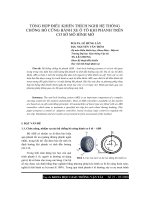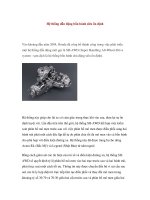Hệ thống dẫn động 4 bánh trên ô tô tiếng anh
Bạn đang xem bản rút gọn của tài liệu. Xem và tải ngay bản đầy đủ của tài liệu tại đây (934.64 KB, 40 trang )
Four-Wheel-Drive
Why Four-Wheel-Drive?
❚ Advantages
❙ Improved traction and handling
❙ Able to transmit torque to all four wheels
❚ Disadvantages
❙ Higher initial cost and weight
❙ Requires special service and maintenance
Definitions
❚ 4X4 = Four wheeled vehicle, four
wheels can receive torque.
❚ 4X2 = Four wheeled vehicle, two
wheels can receive torque.
4WD Designs
❚ RWD vehicles equipped with an added
transfer case, a front drive shaft, a
front differential, and front drive axles
4WD Designs
❚ FWD vehicles with an added transfer case, a rear
drive shaft, and a rear axle
4WD Definitions
❚ Transfer case - An
auxiliary
transmission
mounted to the
side or rear of the
main
transmission.
❙ No differential action is
provided.
4WD Components
❚ Transfer case
❙ Transmits power from the transmission to the front and
rear drive shafts
4WD Components
❚ Transfer case
❙ Will typically be a gear or chain type
Types of Transfer Cases
❚ Drive chain design
❙ Has less weight to
improve fuel economy
❙ Is usually used with
planetary gearsets
❙ Is the most common
design
Types of Transfer Cases
❚ Gear-type
❙ Uses only gear-sets to transfer power
❙ Stronger & more durable
4WD Definitions
❚ Center
differential serves the
same purpose
as a transfer
case but
allows for
differential
operation.
4WD Definitions
❚ Limited-slip center
differential.
Controls differential
operation through
a disc or cone-type
clutch.
❙ Later designs are computer
operated.
4WD Components
❚ Drive shafts
❙ Connect to the front and rear differentials
4WD Components
❚ Universal joints or CV-joints
❙ Are used to connect front axles to the wheel hubs
4WD Definitions
❚ Part-time 4WD - Typically systems
that operate in two-wheel drive until
the driver commands four-wheel
drive operation. Torque is then
divided (50/50 fixed) between the
front and rear drive-shaft.
❙ They do not corner well on dry pavement.
❙ Selection of two- or four-wheel-drive is done by a shifter,
electric switch and/or locking hubs.
Part-Time 4WD Shift
Controls
❚ Electric switch or shift lever
❙ Allows the driver to select
which axles receive power
❙ Power can be directed to:
❘ all four wheels
❘ two wheels
❘ none (neutral)
❙ Some vehicles have a
low-speed range that can
be selected
Part-Time 4WD
❚ Older designs may have different
drive-axle gear ratios.
❙ This will result in a push-pull type action if the vehicle is
driven on dry pavement.
❙ This phenomenon is called drive-line windup.
Part-Time 4WD Shift
Controls
❙ Manual Shift
lever
❙ Some vehicles
have a
low-speed range
that can
be selected
Part-Time 4WD
❚ Locking Hubs
❙ Manual or automatic operation
Part-Time 4WD
❚ Locking Hubs
❙ manual operation
Part-Time 4WD
❚ Locking Hubs
❙ automatic operation - vacuum or electro-magnetically
operated.
Part-Time 4WD
❚ Locking Axles - final differential will be of an
“open” design. When one axle is disconnected
from the wheel the spider gears rotate freely,
neither axle receives torque.
❚ Used with an open differential
Part-Time 4WD
❚ Locking Axles - Toyota’s Automatic
Disconnecting Differential (ADD)
Transfer Case Modes of
Operation
❚ Ranges available with a part-time transfer case:
❙ Neutral
Transfer Case Modes of
Operation
❚ Ranges available with a part-time transfer case:
❙ Two-wheel-drive—high









